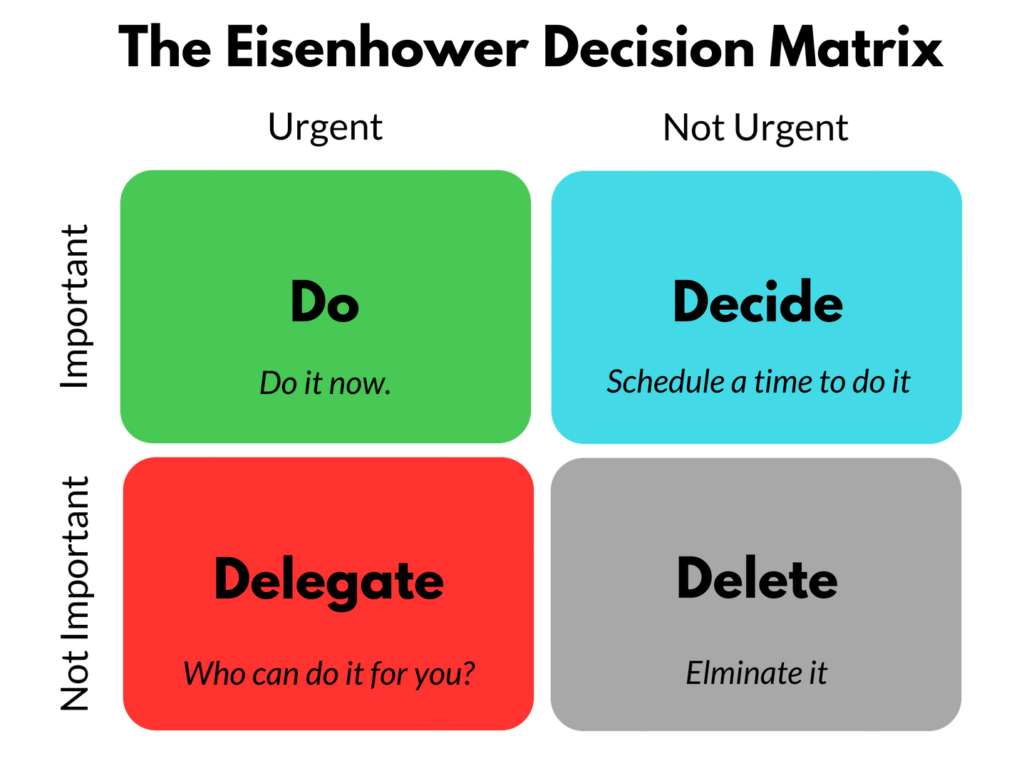The Eisenhower Matrix, also known as the urgent-important matrix, aids in task selection and prioritization by importance and urgency, separating less important and urgent jobs from those that should be delegated or avoided altogether.
Most people spend time on activities that do not help them achieve their objectives. The Eisenhower Matrix will help you break free from that loop. You overlook the crucial activities on your to-do checklist when you spend too long on urgent tasks. It’s easy to get caught in a reactive loop of continuously putting out fires, depriving yourself of the chance to work toward your objectives.
You may focus more time and attention on the things that really matter most by discriminating among urgent and important tasks. The Eisenhower Matrix can help you identify that difference and better manage your time. Let’s go into the details of this Eisenhower Matrix and see how it works.
History of the Matrix
From 1953 to 1961, Dwight D. Eisenhower served as the 34th President of the USA. He was a colonel in the United States Army, and later, he was named NATO’s inaugural supreme commander.
Eisenhower had to make difficult judgments daily as to which of the numerous jobs he should concentrate on. As a result, he developed the now-famous Eisenhower concept, which helps us set priorities based on urgency and importance.
Quadrants of the Eisenhower Matrix

When jobs are prioritized according to their urgency and importance, they are divided into four quadrants, each with its own set of work methodologies.
Quadrant 1: Urgent & Important
Tasks that are urgent and vital are emergencies with deadlines. You could set a timer to assist you in focusing while attempting to complete as many as possible. Reviewing an important paper for your manager is an example of an urgent and important task.
The majority of the time, they are either items that were thrust upon you by an external entity or items that you brushed off until a time limit loomed. In either case, they necessitate a crisis response.
Quadrant 1 responsibilities are unavoidable. There is always something outside your hands, even if you never delay. The issue arises when you place too much emphasis on these unanticipated or deadline-driven chores at the expense of long-term objectives that are essential to you.
Quadrant 2: Not Urgent & Important
Tasks that aren’t urgent but are crucial to your objective and don’t have a tight deadline will help you attain your goal. Put these chores on your to-do list for later. This quadrant gives the most satisfaction because it is where efficient and meaningful people spend most of their time.
Because they may not have a timeline, it’s simple to ignore these tasks in favor of more pressing responsibilities. On the other hand, these duties have a considerably higher impact on your long-term ability to achieve your objectives. Quadrant 2 is the perfect balance of personal multitasking. This is the point at which you are concentrating on growth and opportunities rather than issues.
Functioning in this quadrant of the matrix entails being proactive and prioritizing things that help you develop your talents and energies while also contributing to achieving significant goals. Because you are relatively free of demanding distractions, Quadrant 2 is just where serious work takes place.
Quadrant 3: Urgent & Not Important
Activities in this quadrant are almost often distractions from your desired path. These are tasks in which you assist others in achieving their objectives. Delegate these responsibilities to others. The simple urgency effect is found in Quadrant 3. The pressure to meet deadlines, whether real or imagined, causes you to take on things that aren’t important to you.
Spending lots of time in this quadrant can ruin your schedule because Q3 chores are urgent but usually tied to someone else’s objectives. Focusing on Q3 tasks can help you feel as if you aren’t meeting your broader life goals or that you don’t have influence over your daily life.
Quadrant 4: Not Urgent & Not important
These tasks aren’t urgent, and they won’t help you achieve your long-term objectives. They’re nothing more than a diversion from what really matters. Remove these activities from your to-do list. Quadrant 4 is the sector of abundance and instant enjoyment, which leaves you unsatisfied in the end.
We all require some downtime. Eisenhower was a very renowned bridge player who was infamously chastised for his frequent golf outings while in office. The important thing is that these pursuits provided a healthy counterbalance to the many demanding aspects of being a politician. However, if you aren’t careful, the manner in which you spend your free time might deplete your energy, enthusiasm, and innovation.
Time Saving Tips
- Making a to-do list helps to clear your mind. But constantly ask yourself what the most important thing to do initially is.
- Try to keep each quadrant up to only eight jobs. Finish the most critical ones first before adding others. It’s important to remember that it’s not about accumulating but about completing duties.
- You must only keep one list both for work and personal tasks. You’ll never be able to protest about not doing anything for your home or yourself at the end of the day if you do it this way.
- Allowing yourself or others to divert you is not a good idea. Allowing others to define your priorities is not a good idea. Plan first thing in the morning, then get to work. Finally, savor the sense of accomplishment.





